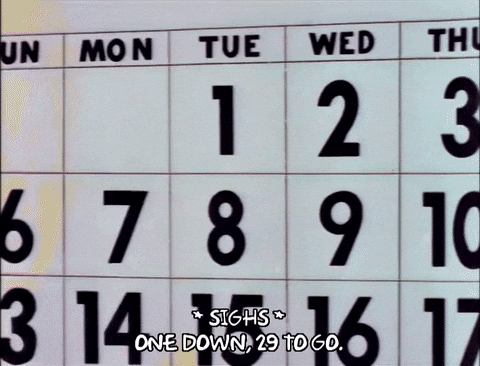12.30.24: How to design a calendar 🗓️
Brief history on calendars, New Year’s Eve and 5 design principles to create your best year yet.
As the year draws to a close, our calendars become our unofficial therapists or worst enemies. They hold the story of the past year—full of crossed-out meetings, scribbled goals, and those occasional blank spaces where you hopefully caught a breath. But before we step into 2025, let’s pause and pivot how we look at the calendar all together.
Why twelve months? Why January to December? And most importantly, how can we use this design to shape our lives for the better?
Let’s dive into the history of calendars, the traditions of New Year’s Eve, and how timeless design principles can help you plan the year ahead.
One of Humanity’s Most Enduring Designs
Calendars are one of humanity’s oldest designs—born not from aesthetics but necessity. Thousands of years ago, ancient civilizations noticed patterns in the sky. The stars shifted, the sun grew stronger, and crops followed predictable rhythms but there was no true rhyme or reason for any of it. Time became a design challenge: How do we organize these patterns into something usable?
From Stars to Systems
The Sumerians were among the first to measure time, creating a lunar calendar over 5,000 years ago. It wasn’t perfect (29.5 days per cycle will mess with your math), but it planted the seeds for a different way of life and thinking about time.
The Egyptians, obsessed with the Nile’s flooding and predicting the best conditions for agricultural activities, introduced a 365-day solar calendar, anchored by the rising of Sirius in the sky. Sound familiar?
Enter the Romans, whose early calendars were chaotic, tied to the whims of politics. It wasn’t until Julius Caesar overhauled the system in 45 BCE that we got something close to today’s structure: the Julian Calendar. He added leap years and shifted the year’s start to January, honoring Janus, the Roman god of beginnings and transitions.
Fast-forward to 1582, and we find ourselves under the Gregorian Calendar, introduced by Pope Gregory XIII to correct slight errors in the Julian model. This system, with its precise leap year adjustments, spread like wildfire across the Western world—thanks to colonialism and global trade.
Today, the Gregorian Calendar dominates, but many cultures still hold onto their own timekeeping traditions. Lunar New Year, Rosh Hashanah, and Diwali remind us there’s more than one way to design a year.
In each case, and countless more i’m not mentioning, calendars didn’t just evolve to track time; they shaped it.
New Year’s Eve: The Intersection of Reflection and Intention
The concept of celebrating a new year is as old as calendars themselves, going back 4,000 years to the Babylonians, who tied their festivities to the spring equinox. For them, it was a chance to honor renewal and fresh starts. The Romans, however, shifted the date to January 1st, named for Janus, the two-faced god of beginnings and transitions. With one face looking back and the other looking forward, Janus offers us a clear metaphor: the end of the year is a perfect time to reflect on the past and plan for the future.
Modern New Year’s traditions—fireworks, resolutions, staying up past midnight—may seem like meaningless fun, but they’re rooted in a deep human desire: to mark the passing of time and take control of what comes next.
Timeless design principles to create your best year yet
There is a valuable lesson hidden within all that historical context, You have the power to shape time with your calendar too.
So here’s 5 design principles that you can apply to create your best year yet.
1. Clarity: Design a System That Works for You
Think of your calendar as your personal operating system. Whether it’s digital, paper, or a mix of both, choose a format that aligns with how you think. Need color-coded categories? Add them. Prefer bullet points? Keep it simple.
Actionable Tip: Spend an hour creating a calendar system for 2025 that you’ll actually use. Break it into:
Non-negotiables (work deadlines, family commitments)
Priorities (goals like fitness, learning, or creative projects)
Flex Time (blank spaces for spontaneity and rest).
2. Intentionality: Plan Around What Matters Most
The Gregorian Calendar reshaped how humanity aligned with time. You can do the same by focusing your year on what truly matters to you.
Actionable Tip: Identify your top three priorities for 2025. Then, plan your goals around seasons. For example:
Winter: Learn a new skill.
Spring: Focus on health.
Summer: Build relationships.
Fall: Reflect and refine.
Seasons create natural momentum, just like they do for nature.
3. Iteration: Adjust As You Go
The calendar we use today wasn’t perfect from the start. The Julian Calendar had errors. The Gregorian Calendar fixed them. The same goes for your plans—design with room to iterate.
Actionable Tip: Every month, take 30 minutes to review what’s working and what’s not. Adjust deadlines, remove goals that feel forced, and celebrate small wins. Think of it as a design review for your life.
4. Storytelling: Tie Your Plans to Something Bigger
Good design tells a story. A calendar isn’t just a collection of dates—it’s a tool that reflects cultural values and collective goals. What story will your year tell?
Actionable Tip: Write a mission statement for 2025. A single sentence that reminds you why this year matters. For example:
“2025 is my year to focus on health and creativity.”
“This year, I’ll prioritize meaningful relationships and personal growth.”
Keep it visible—on your phone, fridge, or desk.
5. Balance: Celebrate Along the Way
New Year’s Eve is a celebration of time itself. It reminds us to pause and enjoy the moments we’ve worked for.
Actionable Tip: Schedule your own “mini New Year’s Eves” throughout the year. Once a quarter, dedicate a day to celebrate progress, reflect on setbacks, and recharge for the months ahead.
Final Thoughts: Design the Year You Want to Live
The tools you use to plan your year—your calendar, your goals, your habits—shouldn’t feel rigid. They should feel like partners in helping you thrive and bend time to your will.
So as you step into 2025, think about how you’ll design your year with intention, clarity, and balance. Just like the Gregorian Calendar took centuries to perfect, your plans will evolve. But every step is part of the design process.
So, grab your champagne (or your planner), and start designing. Here’s to a beautifully crafted 2025.






